Employee Motivation and Business Performance: A Dissertation Study
VerifiedAdded on 2020/02/05
|83
|25921
|157
Dissertation
AI Summary
This dissertation investigates the crucial connection between employee motivation and organizational performance, focusing on Next Plc as a case study. The study delves into various motivational theories, including Herzberg's two-factor theory and Maslow's hierarchy of needs, to assess their impact on employee behavior and business outcomes. It explores the importance of both financial and non-financial incentives, such as rewards and recognition programs, in driving desired results and enhancing customer satisfaction. The research examines different motivational approaches, analyzing their effectiveness in improving worker commitment, productivity, and overall business success. The dissertation also addresses the challenges faced by organizations in motivating their workforce and provides recommendations for implementing effective strategies to achieve improved business performance and maintain a competitive edge in the retail industry.
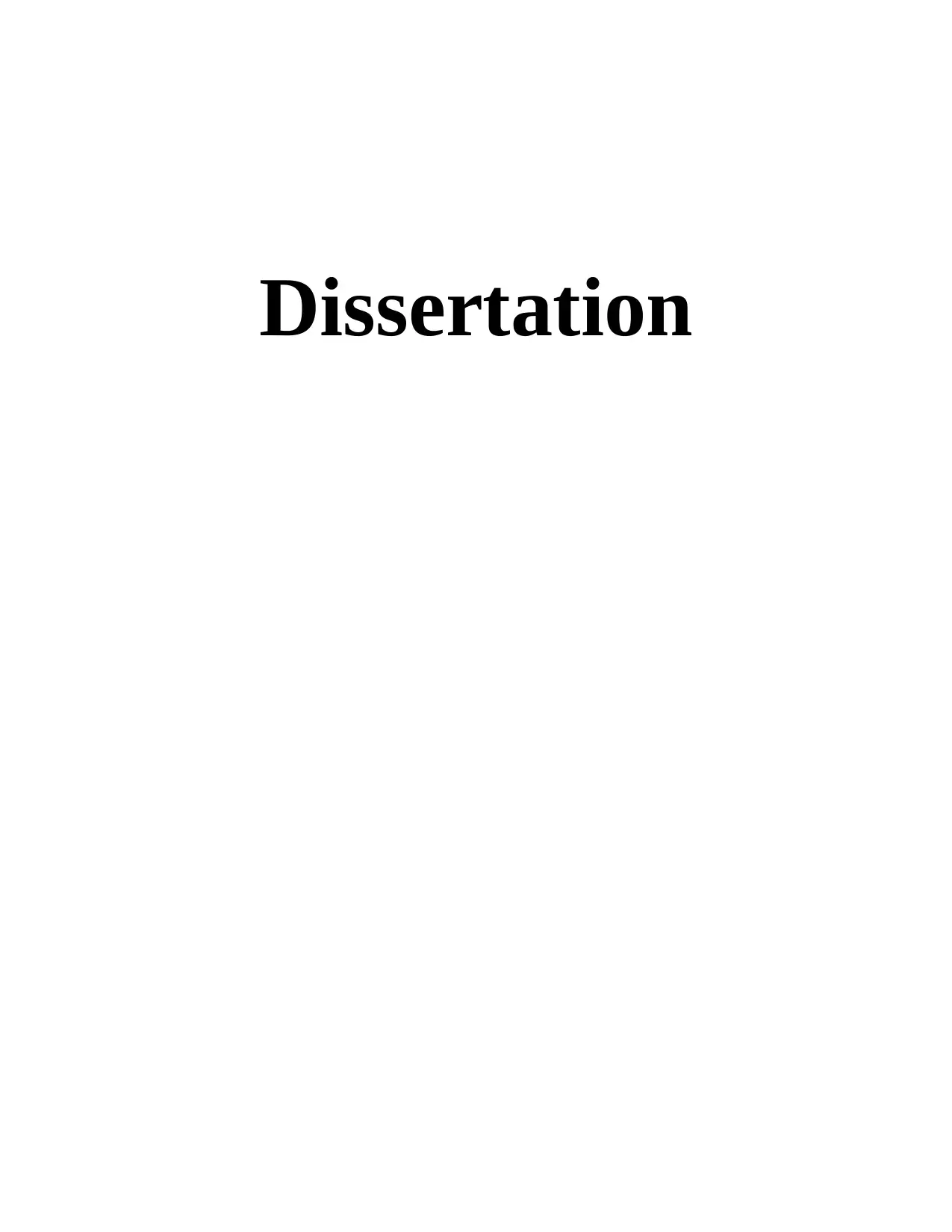
Dissertation
Paraphrase This Document
Need a fresh take? Get an instant paraphrase of this document with our AI Paraphraser
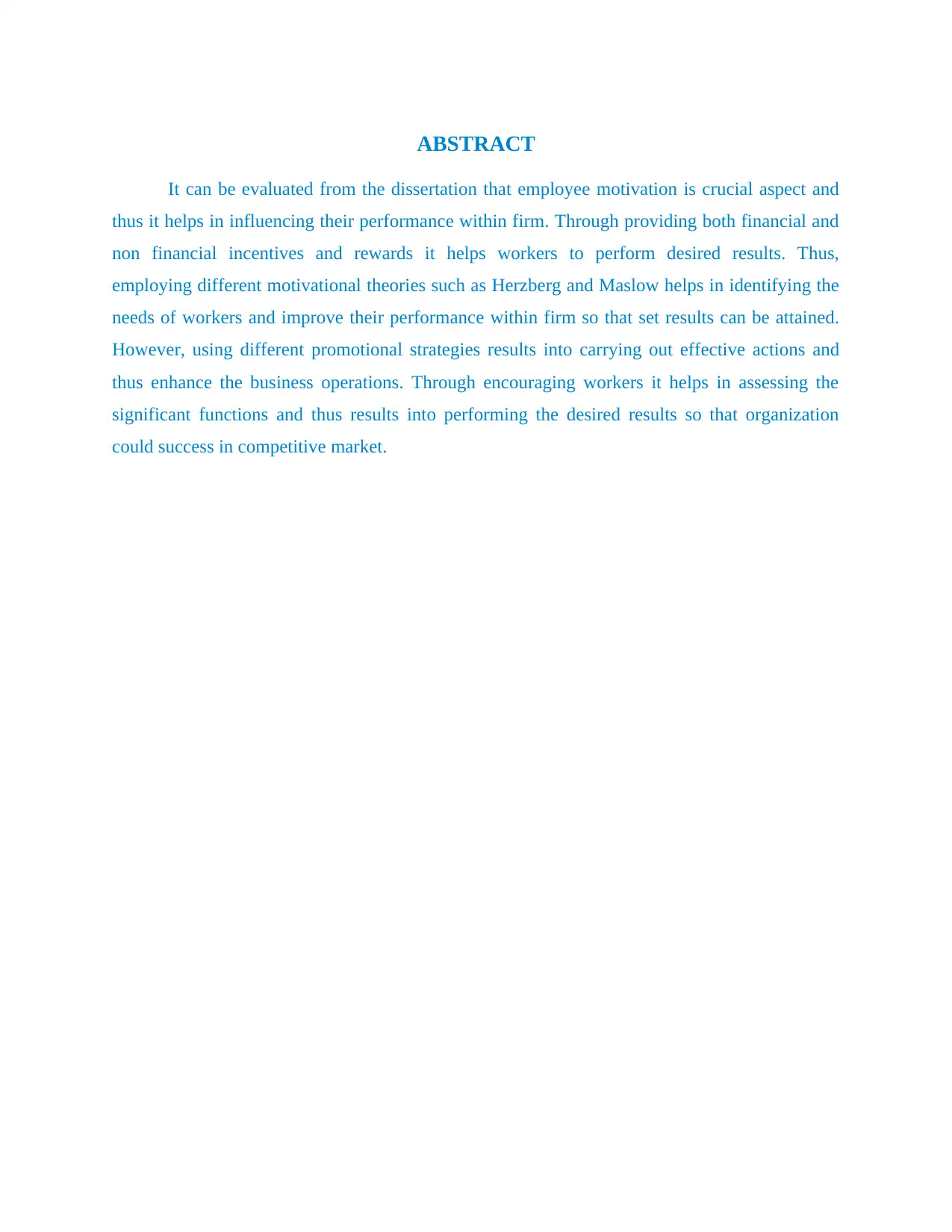
ABSTRACT
It can be evaluated from the dissertation that employee motivation is crucial aspect and
thus it helps in influencing their performance within firm. Through providing both financial and
non financial incentives and rewards it helps workers to perform desired results. Thus,
employing different motivational theories such as Herzberg and Maslow helps in identifying the
needs of workers and improve their performance within firm so that set results can be attained.
However, using different promotional strategies results into carrying out effective actions and
thus enhance the business operations. Through encouraging workers it helps in assessing the
significant functions and thus results into performing the desired results so that organization
could success in competitive market.
It can be evaluated from the dissertation that employee motivation is crucial aspect and
thus it helps in influencing their performance within firm. Through providing both financial and
non financial incentives and rewards it helps workers to perform desired results. Thus,
employing different motivational theories such as Herzberg and Maslow helps in identifying the
needs of workers and improve their performance within firm so that set results can be attained.
However, using different promotional strategies results into carrying out effective actions and
thus enhance the business operations. Through encouraging workers it helps in assessing the
significant functions and thus results into performing the desired results so that organization
could success in competitive market.
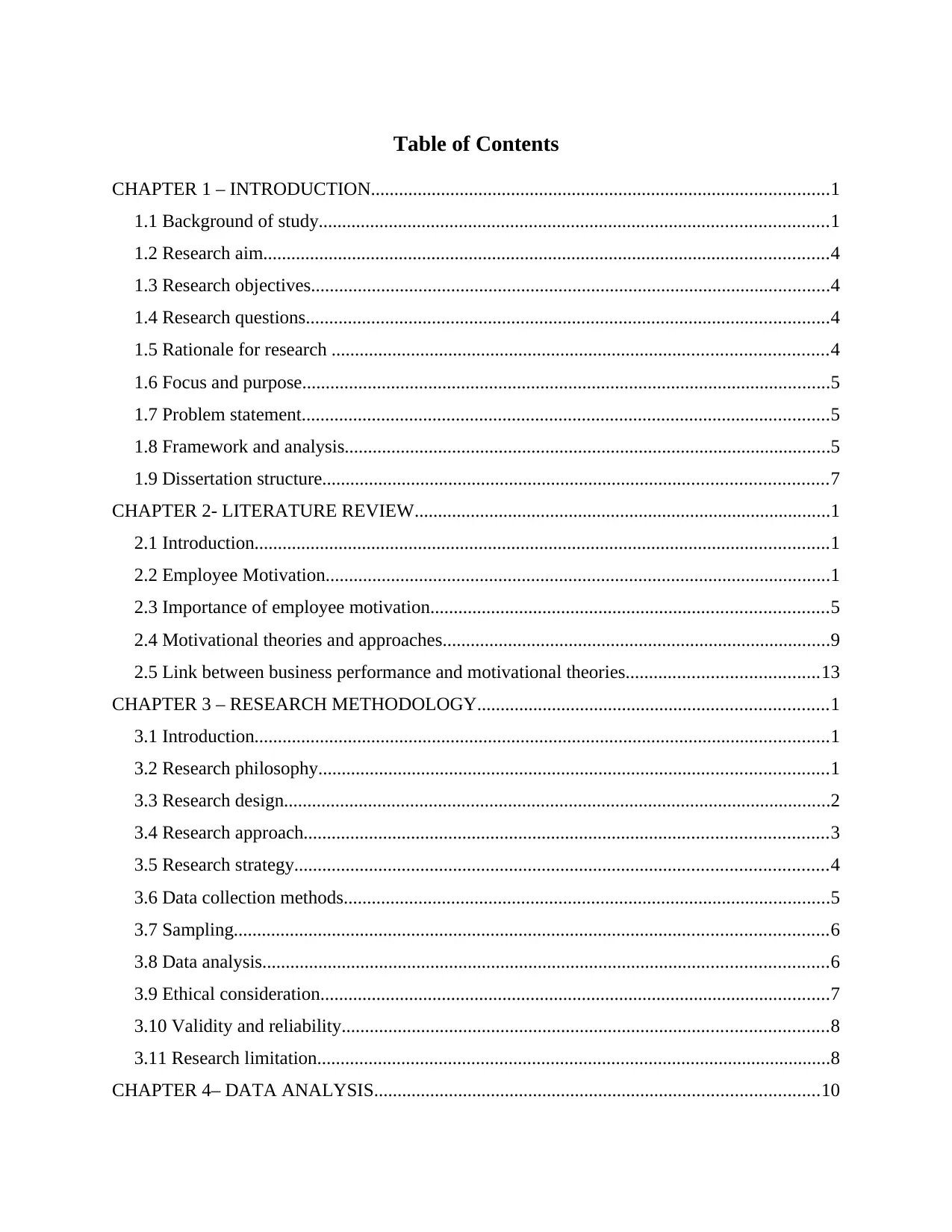
Table of Contents
CHAPTER 1 – INTRODUCTION..................................................................................................1
1.1 Background of study.............................................................................................................1
1.2 Research aim.........................................................................................................................4
1.3 Research objectives...............................................................................................................4
1.4 Research questions................................................................................................................4
1.5 Rationale for research ..........................................................................................................4
1.6 Focus and purpose.................................................................................................................5
1.7 Problem statement.................................................................................................................5
1.8 Framework and analysis........................................................................................................5
1.9 Dissertation structure............................................................................................................7
CHAPTER 2- LITERATURE REVIEW.........................................................................................1
2.1 Introduction...........................................................................................................................1
2.2 Employee Motivation............................................................................................................1
2.3 Importance of employee motivation.....................................................................................5
2.4 Motivational theories and approaches...................................................................................9
2.5 Link between business performance and motivational theories.........................................13
CHAPTER 3 – RESEARCH METHODOLOGY...........................................................................1
3.1 Introduction...........................................................................................................................1
3.2 Research philosophy.............................................................................................................1
3.3 Research design.....................................................................................................................2
3.4 Research approach................................................................................................................3
3.5 Research strategy..................................................................................................................4
3.6 Data collection methods........................................................................................................5
3.7 Sampling...............................................................................................................................6
3.8 Data analysis.........................................................................................................................6
3.9 Ethical consideration.............................................................................................................7
3.10 Validity and reliability........................................................................................................8
3.11 Research limitation..............................................................................................................8
CHAPTER 4– DATA ANALYSIS...............................................................................................10
CHAPTER 1 – INTRODUCTION..................................................................................................1
1.1 Background of study.............................................................................................................1
1.2 Research aim.........................................................................................................................4
1.3 Research objectives...............................................................................................................4
1.4 Research questions................................................................................................................4
1.5 Rationale for research ..........................................................................................................4
1.6 Focus and purpose.................................................................................................................5
1.7 Problem statement.................................................................................................................5
1.8 Framework and analysis........................................................................................................5
1.9 Dissertation structure............................................................................................................7
CHAPTER 2- LITERATURE REVIEW.........................................................................................1
2.1 Introduction...........................................................................................................................1
2.2 Employee Motivation............................................................................................................1
2.3 Importance of employee motivation.....................................................................................5
2.4 Motivational theories and approaches...................................................................................9
2.5 Link between business performance and motivational theories.........................................13
CHAPTER 3 – RESEARCH METHODOLOGY...........................................................................1
3.1 Introduction...........................................................................................................................1
3.2 Research philosophy.............................................................................................................1
3.3 Research design.....................................................................................................................2
3.4 Research approach................................................................................................................3
3.5 Research strategy..................................................................................................................4
3.6 Data collection methods........................................................................................................5
3.7 Sampling...............................................................................................................................6
3.8 Data analysis.........................................................................................................................6
3.9 Ethical consideration.............................................................................................................7
3.10 Validity and reliability........................................................................................................8
3.11 Research limitation..............................................................................................................8
CHAPTER 4– DATA ANALYSIS...............................................................................................10
⊘ This is a preview!⊘
Do you want full access?
Subscribe today to unlock all pages.

Trusted by 1+ million students worldwide
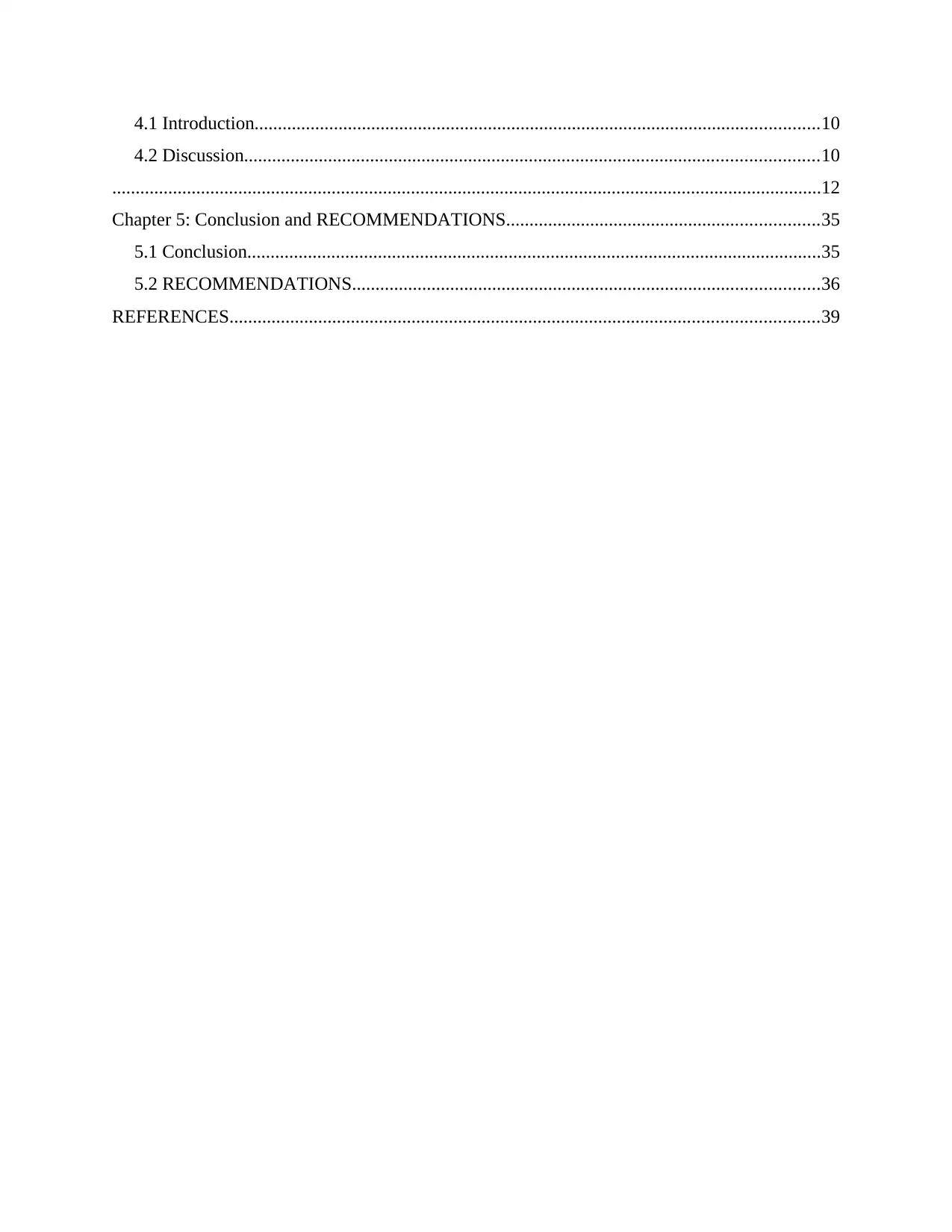
4.1 Introduction.........................................................................................................................10
4.2 Discussion...........................................................................................................................10
........................................................................................................................................................12
Chapter 5: Conclusion and RECOMMENDATIONS...................................................................35
5.1 Conclusion...........................................................................................................................35
5.2 RECOMMENDATIONS....................................................................................................36
REFERENCES..............................................................................................................................39
4.2 Discussion...........................................................................................................................10
........................................................................................................................................................12
Chapter 5: Conclusion and RECOMMENDATIONS...................................................................35
5.1 Conclusion...........................................................................................................................35
5.2 RECOMMENDATIONS....................................................................................................36
REFERENCES..............................................................................................................................39
Paraphrase This Document
Need a fresh take? Get an instant paraphrase of this document with our AI Paraphraser
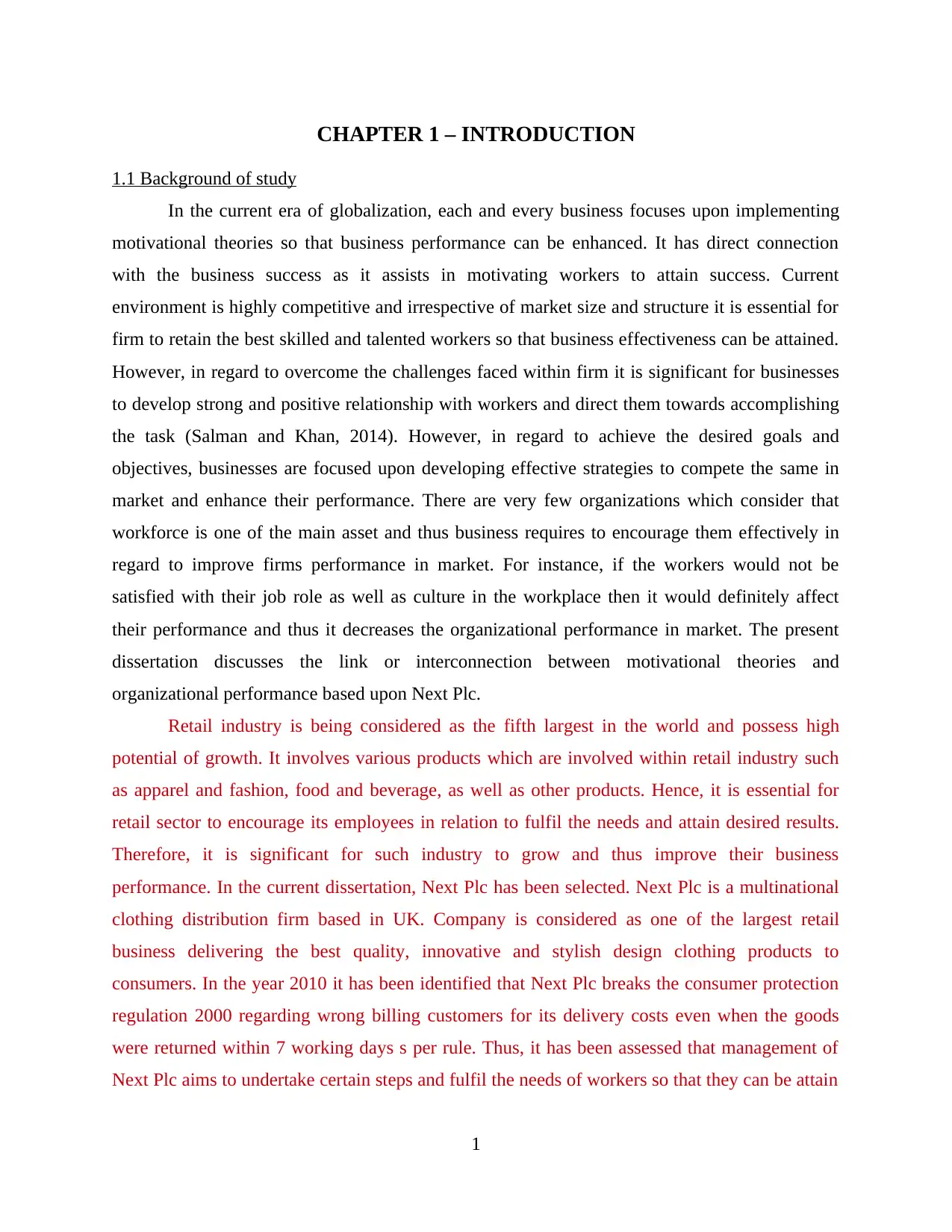
CHAPTER 1 – INTRODUCTION
1.1 Background of study
In the current era of globalization, each and every business focuses upon implementing
motivational theories so that business performance can be enhanced. It has direct connection
with the business success as it assists in motivating workers to attain success. Current
environment is highly competitive and irrespective of market size and structure it is essential for
firm to retain the best skilled and talented workers so that business effectiveness can be attained.
However, in regard to overcome the challenges faced within firm it is significant for businesses
to develop strong and positive relationship with workers and direct them towards accomplishing
the task (Salman and Khan, 2014). However, in regard to achieve the desired goals and
objectives, businesses are focused upon developing effective strategies to compete the same in
market and enhance their performance. There are very few organizations which consider that
workforce is one of the main asset and thus business requires to encourage them effectively in
regard to improve firms performance in market. For instance, if the workers would not be
satisfied with their job role as well as culture in the workplace then it would definitely affect
their performance and thus it decreases the organizational performance in market. The present
dissertation discusses the link or interconnection between motivational theories and
organizational performance based upon Next Plc.
Retail industry is being considered as the fifth largest in the world and possess high
potential of growth. It involves various products which are involved within retail industry such
as apparel and fashion, food and beverage, as well as other products. Hence, it is essential for
retail sector to encourage its employees in relation to fulfil the needs and attain desired results.
Therefore, it is significant for such industry to grow and thus improve their business
performance. In the current dissertation, Next Plc has been selected. Next Plc is a multinational
clothing distribution firm based in UK. Company is considered as one of the largest retail
business delivering the best quality, innovative and stylish design clothing products to
consumers. In the year 2010 it has been identified that Next Plc breaks the consumer protection
regulation 2000 regarding wrong billing customers for its delivery costs even when the goods
were returned within 7 working days s per rule. Thus, it has been assessed that management of
Next Plc aims to undertake certain steps and fulfil the needs of workers so that they can be attain
1
1.1 Background of study
In the current era of globalization, each and every business focuses upon implementing
motivational theories so that business performance can be enhanced. It has direct connection
with the business success as it assists in motivating workers to attain success. Current
environment is highly competitive and irrespective of market size and structure it is essential for
firm to retain the best skilled and talented workers so that business effectiveness can be attained.
However, in regard to overcome the challenges faced within firm it is significant for businesses
to develop strong and positive relationship with workers and direct them towards accomplishing
the task (Salman and Khan, 2014). However, in regard to achieve the desired goals and
objectives, businesses are focused upon developing effective strategies to compete the same in
market and enhance their performance. There are very few organizations which consider that
workforce is one of the main asset and thus business requires to encourage them effectively in
regard to improve firms performance in market. For instance, if the workers would not be
satisfied with their job role as well as culture in the workplace then it would definitely affect
their performance and thus it decreases the organizational performance in market. The present
dissertation discusses the link or interconnection between motivational theories and
organizational performance based upon Next Plc.
Retail industry is being considered as the fifth largest in the world and possess high
potential of growth. It involves various products which are involved within retail industry such
as apparel and fashion, food and beverage, as well as other products. Hence, it is essential for
retail sector to encourage its employees in relation to fulfil the needs and attain desired results.
Therefore, it is significant for such industry to grow and thus improve their business
performance. In the current dissertation, Next Plc has been selected. Next Plc is a multinational
clothing distribution firm based in UK. Company is considered as one of the largest retail
business delivering the best quality, innovative and stylish design clothing products to
consumers. In the year 2010 it has been identified that Next Plc breaks the consumer protection
regulation 2000 regarding wrong billing customers for its delivery costs even when the goods
were returned within 7 working days s per rule. Thus, it has been assessed that management of
Next Plc aims to undertake certain steps and fulfil the needs of workers so that they can be attain
1
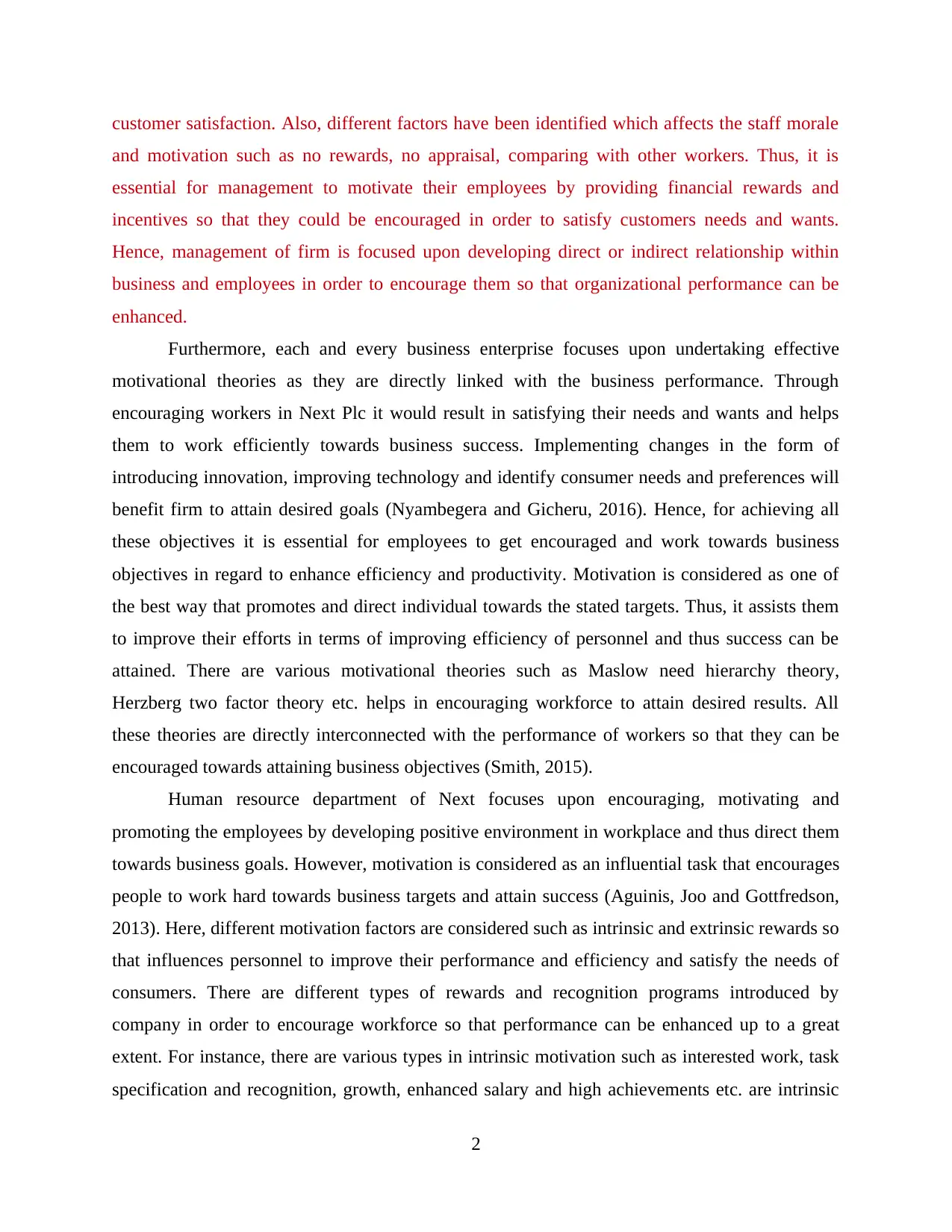
customer satisfaction. Also, different factors have been identified which affects the staff morale
and motivation such as no rewards, no appraisal, comparing with other workers. Thus, it is
essential for management to motivate their employees by providing financial rewards and
incentives so that they could be encouraged in order to satisfy customers needs and wants.
Hence, management of firm is focused upon developing direct or indirect relationship within
business and employees in order to encourage them so that organizational performance can be
enhanced.
Furthermore, each and every business enterprise focuses upon undertaking effective
motivational theories as they are directly linked with the business performance. Through
encouraging workers in Next Plc it would result in satisfying their needs and wants and helps
them to work efficiently towards business success. Implementing changes in the form of
introducing innovation, improving technology and identify consumer needs and preferences will
benefit firm to attain desired goals (Nyambegera and Gicheru, 2016). Hence, for achieving all
these objectives it is essential for employees to get encouraged and work towards business
objectives in regard to enhance efficiency and productivity. Motivation is considered as one of
the best way that promotes and direct individual towards the stated targets. Thus, it assists them
to improve their efforts in terms of improving efficiency of personnel and thus success can be
attained. There are various motivational theories such as Maslow need hierarchy theory,
Herzberg two factor theory etc. helps in encouraging workforce to attain desired results. All
these theories are directly interconnected with the performance of workers so that they can be
encouraged towards attaining business objectives (Smith, 2015).
Human resource department of Next focuses upon encouraging, motivating and
promoting the employees by developing positive environment in workplace and thus direct them
towards business goals. However, motivation is considered as an influential task that encourages
people to work hard towards business targets and attain success (Aguinis, Joo and Gottfredson,
2013). Here, different motivation factors are considered such as intrinsic and extrinsic rewards so
that influences personnel to improve their performance and efficiency and satisfy the needs of
consumers. There are different types of rewards and recognition programs introduced by
company in order to encourage workforce so that performance can be enhanced up to a great
extent. For instance, there are various types in intrinsic motivation such as interested work, task
specification and recognition, growth, enhanced salary and high achievements etc. are intrinsic
2
and motivation such as no rewards, no appraisal, comparing with other workers. Thus, it is
essential for management to motivate their employees by providing financial rewards and
incentives so that they could be encouraged in order to satisfy customers needs and wants.
Hence, management of firm is focused upon developing direct or indirect relationship within
business and employees in order to encourage them so that organizational performance can be
enhanced.
Furthermore, each and every business enterprise focuses upon undertaking effective
motivational theories as they are directly linked with the business performance. Through
encouraging workers in Next Plc it would result in satisfying their needs and wants and helps
them to work efficiently towards business success. Implementing changes in the form of
introducing innovation, improving technology and identify consumer needs and preferences will
benefit firm to attain desired goals (Nyambegera and Gicheru, 2016). Hence, for achieving all
these objectives it is essential for employees to get encouraged and work towards business
objectives in regard to enhance efficiency and productivity. Motivation is considered as one of
the best way that promotes and direct individual towards the stated targets. Thus, it assists them
to improve their efforts in terms of improving efficiency of personnel and thus success can be
attained. There are various motivational theories such as Maslow need hierarchy theory,
Herzberg two factor theory etc. helps in encouraging workforce to attain desired results. All
these theories are directly interconnected with the performance of workers so that they can be
encouraged towards attaining business objectives (Smith, 2015).
Human resource department of Next focuses upon encouraging, motivating and
promoting the employees by developing positive environment in workplace and thus direct them
towards business goals. However, motivation is considered as an influential task that encourages
people to work hard towards business targets and attain success (Aguinis, Joo and Gottfredson,
2013). Here, different motivation factors are considered such as intrinsic and extrinsic rewards so
that influences personnel to improve their performance and efficiency and satisfy the needs of
consumers. There are different types of rewards and recognition programs introduced by
company in order to encourage workforce so that performance can be enhanced up to a great
extent. For instance, there are various types in intrinsic motivation such as interested work, task
specification and recognition, growth, enhanced salary and high achievements etc. are intrinsic
2
⊘ This is a preview!⊘
Do you want full access?
Subscribe today to unlock all pages.

Trusted by 1+ million students worldwide
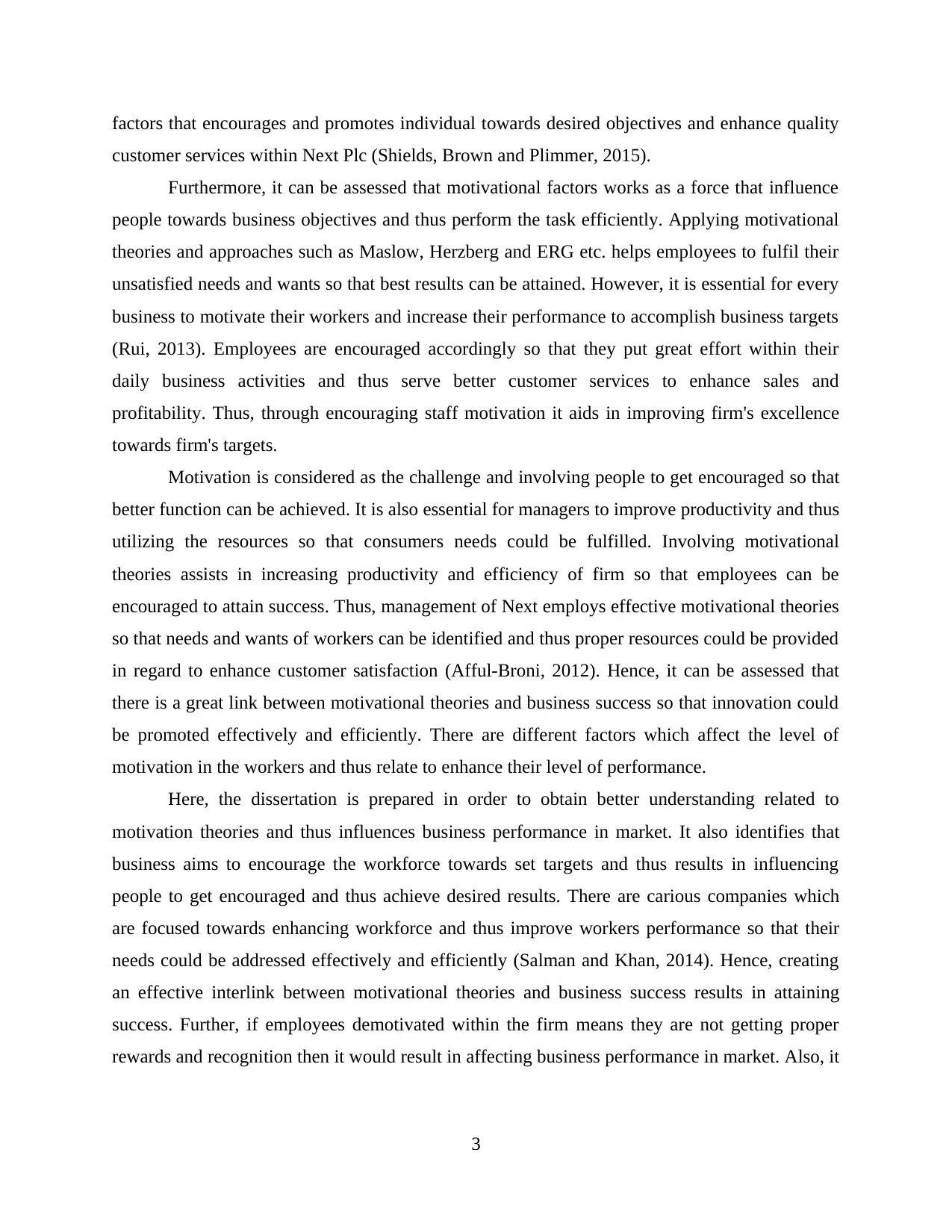
factors that encourages and promotes individual towards desired objectives and enhance quality
customer services within Next Plc (Shields, Brown and Plimmer, 2015).
Furthermore, it can be assessed that motivational factors works as a force that influence
people towards business objectives and thus perform the task efficiently. Applying motivational
theories and approaches such as Maslow, Herzberg and ERG etc. helps employees to fulfil their
unsatisfied needs and wants so that best results can be attained. However, it is essential for every
business to motivate their workers and increase their performance to accomplish business targets
(Rui, 2013). Employees are encouraged accordingly so that they put great effort within their
daily business activities and thus serve better customer services to enhance sales and
profitability. Thus, through encouraging staff motivation it aids in improving firm's excellence
towards firm's targets.
Motivation is considered as the challenge and involving people to get encouraged so that
better function can be achieved. It is also essential for managers to improve productivity and thus
utilizing the resources so that consumers needs could be fulfilled. Involving motivational
theories assists in increasing productivity and efficiency of firm so that employees can be
encouraged to attain success. Thus, management of Next employs effective motivational theories
so that needs and wants of workers can be identified and thus proper resources could be provided
in regard to enhance customer satisfaction (Afful-Broni, 2012). Hence, it can be assessed that
there is a great link between motivational theories and business success so that innovation could
be promoted effectively and efficiently. There are different factors which affect the level of
motivation in the workers and thus relate to enhance their level of performance.
Here, the dissertation is prepared in order to obtain better understanding related to
motivation theories and thus influences business performance in market. It also identifies that
business aims to encourage the workforce towards set targets and thus results in influencing
people to get encouraged and thus achieve desired results. There are carious companies which
are focused towards enhancing workforce and thus improve workers performance so that their
needs could be addressed effectively and efficiently (Salman and Khan, 2014). Hence, creating
an effective interlink between motivational theories and business success results in attaining
success. Further, if employees demotivated within the firm means they are not getting proper
rewards and recognition then it would result in affecting business performance in market. Also, it
3
customer services within Next Plc (Shields, Brown and Plimmer, 2015).
Furthermore, it can be assessed that motivational factors works as a force that influence
people towards business objectives and thus perform the task efficiently. Applying motivational
theories and approaches such as Maslow, Herzberg and ERG etc. helps employees to fulfil their
unsatisfied needs and wants so that best results can be attained. However, it is essential for every
business to motivate their workers and increase their performance to accomplish business targets
(Rui, 2013). Employees are encouraged accordingly so that they put great effort within their
daily business activities and thus serve better customer services to enhance sales and
profitability. Thus, through encouraging staff motivation it aids in improving firm's excellence
towards firm's targets.
Motivation is considered as the challenge and involving people to get encouraged so that
better function can be achieved. It is also essential for managers to improve productivity and thus
utilizing the resources so that consumers needs could be fulfilled. Involving motivational
theories assists in increasing productivity and efficiency of firm so that employees can be
encouraged to attain success. Thus, management of Next employs effective motivational theories
so that needs and wants of workers can be identified and thus proper resources could be provided
in regard to enhance customer satisfaction (Afful-Broni, 2012). Hence, it can be assessed that
there is a great link between motivational theories and business success so that innovation could
be promoted effectively and efficiently. There are different factors which affect the level of
motivation in the workers and thus relate to enhance their level of performance.
Here, the dissertation is prepared in order to obtain better understanding related to
motivation theories and thus influences business performance in market. It also identifies that
business aims to encourage the workforce towards set targets and thus results in influencing
people to get encouraged and thus achieve desired results. There are carious companies which
are focused towards enhancing workforce and thus improve workers performance so that their
needs could be addressed effectively and efficiently (Salman and Khan, 2014). Hence, creating
an effective interlink between motivational theories and business success results in attaining
success. Further, if employees demotivated within the firm means they are not getting proper
rewards and recognition then it would result in affecting business performance in market. Also, it
3
Paraphrase This Document
Need a fresh take? Get an instant paraphrase of this document with our AI Paraphraser
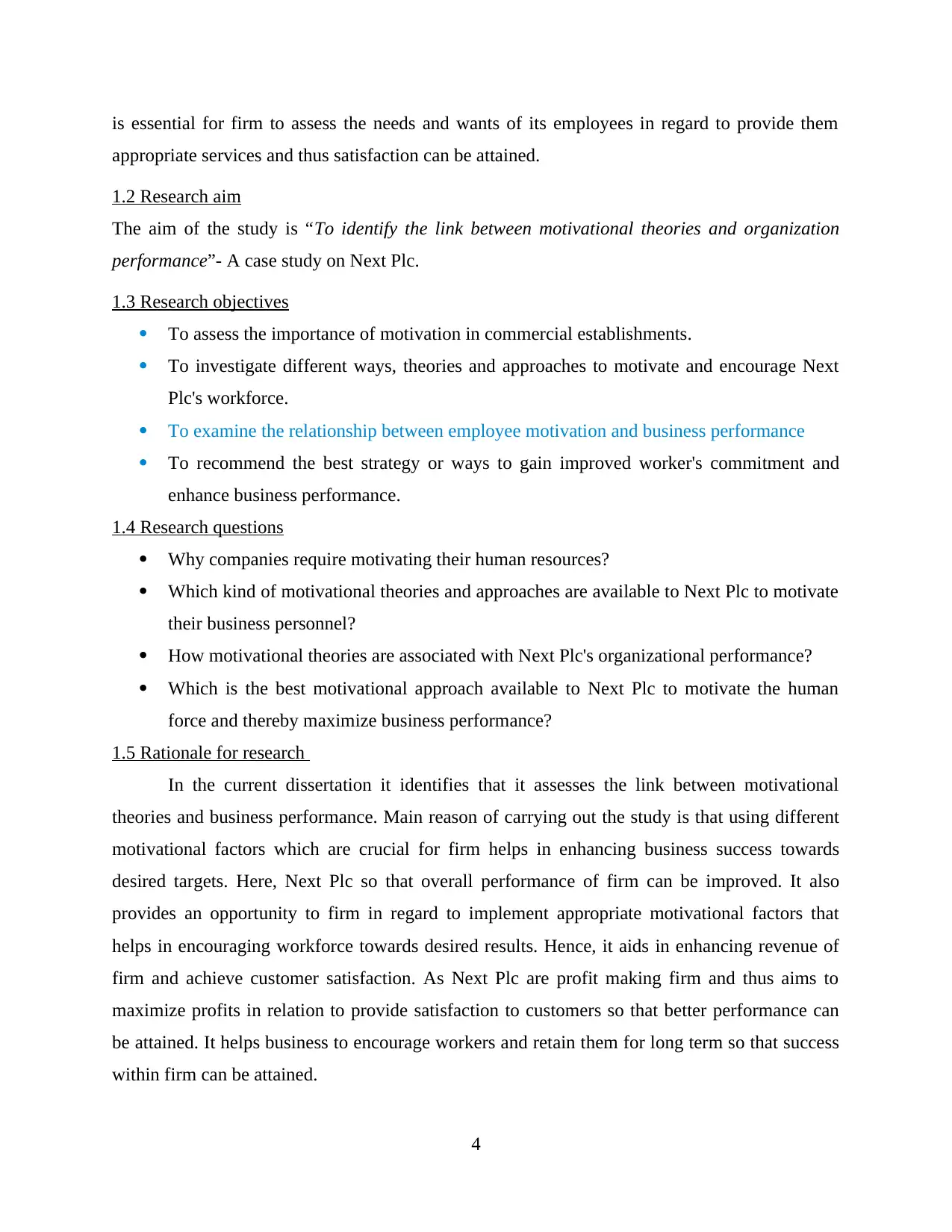
is essential for firm to assess the needs and wants of its employees in regard to provide them
appropriate services and thus satisfaction can be attained.
1.2 Research aim
The aim of the study is “To identify the link between motivational theories and organization
performance”- A case study on Next Plc.
1.3 Research objectives
To assess the importance of motivation in commercial establishments.
To investigate different ways, theories and approaches to motivate and encourage Next
Plc's workforce.
To examine the relationship between employee motivation and business performance
To recommend the best strategy or ways to gain improved worker's commitment and
enhance business performance.
1.4 Research questions
Why companies require motivating their human resources?
Which kind of motivational theories and approaches are available to Next Plc to motivate
their business personnel?
How motivational theories are associated with Next Plc's organizational performance?
Which is the best motivational approach available to Next Plc to motivate the human
force and thereby maximize business performance?
1.5 Rationale for research
In the current dissertation it identifies that it assesses the link between motivational
theories and business performance. Main reason of carrying out the study is that using different
motivational factors which are crucial for firm helps in enhancing business success towards
desired targets. Here, Next Plc so that overall performance of firm can be improved. It also
provides an opportunity to firm in regard to implement appropriate motivational factors that
helps in encouraging workforce towards desired results. Hence, it aids in enhancing revenue of
firm and achieve customer satisfaction. As Next Plc are profit making firm and thus aims to
maximize profits in relation to provide satisfaction to customers so that better performance can
be attained. It helps business to encourage workers and retain them for long term so that success
within firm can be attained.
4
appropriate services and thus satisfaction can be attained.
1.2 Research aim
The aim of the study is “To identify the link between motivational theories and organization
performance”- A case study on Next Plc.
1.3 Research objectives
To assess the importance of motivation in commercial establishments.
To investigate different ways, theories and approaches to motivate and encourage Next
Plc's workforce.
To examine the relationship between employee motivation and business performance
To recommend the best strategy or ways to gain improved worker's commitment and
enhance business performance.
1.4 Research questions
Why companies require motivating their human resources?
Which kind of motivational theories and approaches are available to Next Plc to motivate
their business personnel?
How motivational theories are associated with Next Plc's organizational performance?
Which is the best motivational approach available to Next Plc to motivate the human
force and thereby maximize business performance?
1.5 Rationale for research
In the current dissertation it identifies that it assesses the link between motivational
theories and business performance. Main reason of carrying out the study is that using different
motivational factors which are crucial for firm helps in enhancing business success towards
desired targets. Here, Next Plc so that overall performance of firm can be improved. It also
provides an opportunity to firm in regard to implement appropriate motivational factors that
helps in encouraging workforce towards desired results. Hence, it aids in enhancing revenue of
firm and achieve customer satisfaction. As Next Plc are profit making firm and thus aims to
maximize profits in relation to provide satisfaction to customers so that better performance can
be attained. It helps business to encourage workers and retain them for long term so that success
within firm can be attained.
4
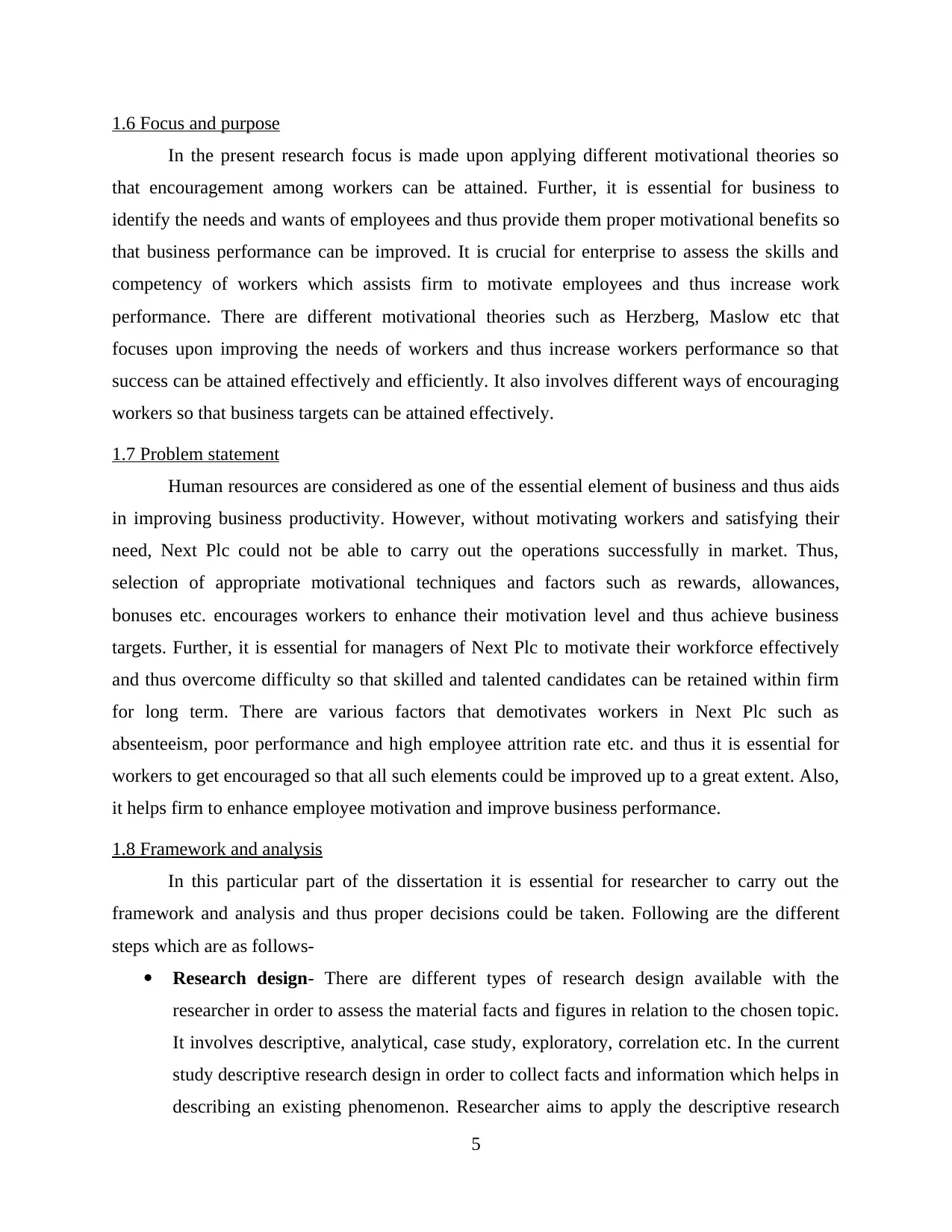
1.6 Focus and purpose
In the present research focus is made upon applying different motivational theories so
that encouragement among workers can be attained. Further, it is essential for business to
identify the needs and wants of employees and thus provide them proper motivational benefits so
that business performance can be improved. It is crucial for enterprise to assess the skills and
competency of workers which assists firm to motivate employees and thus increase work
performance. There are different motivational theories such as Herzberg, Maslow etc that
focuses upon improving the needs of workers and thus increase workers performance so that
success can be attained effectively and efficiently. It also involves different ways of encouraging
workers so that business targets can be attained effectively.
1.7 Problem statement
Human resources are considered as one of the essential element of business and thus aids
in improving business productivity. However, without motivating workers and satisfying their
need, Next Plc could not be able to carry out the operations successfully in market. Thus,
selection of appropriate motivational techniques and factors such as rewards, allowances,
bonuses etc. encourages workers to enhance their motivation level and thus achieve business
targets. Further, it is essential for managers of Next Plc to motivate their workforce effectively
and thus overcome difficulty so that skilled and talented candidates can be retained within firm
for long term. There are various factors that demotivates workers in Next Plc such as
absenteeism, poor performance and high employee attrition rate etc. and thus it is essential for
workers to get encouraged so that all such elements could be improved up to a great extent. Also,
it helps firm to enhance employee motivation and improve business performance.
1.8 Framework and analysis
In this particular part of the dissertation it is essential for researcher to carry out the
framework and analysis and thus proper decisions could be taken. Following are the different
steps which are as follows-
Research design- There are different types of research design available with the
researcher in order to assess the material facts and figures in relation to the chosen topic.
It involves descriptive, analytical, case study, exploratory, correlation etc. In the current
study descriptive research design in order to collect facts and information which helps in
describing an existing phenomenon. Researcher aims to apply the descriptive research
5
In the present research focus is made upon applying different motivational theories so
that encouragement among workers can be attained. Further, it is essential for business to
identify the needs and wants of employees and thus provide them proper motivational benefits so
that business performance can be improved. It is crucial for enterprise to assess the skills and
competency of workers which assists firm to motivate employees and thus increase work
performance. There are different motivational theories such as Herzberg, Maslow etc that
focuses upon improving the needs of workers and thus increase workers performance so that
success can be attained effectively and efficiently. It also involves different ways of encouraging
workers so that business targets can be attained effectively.
1.7 Problem statement
Human resources are considered as one of the essential element of business and thus aids
in improving business productivity. However, without motivating workers and satisfying their
need, Next Plc could not be able to carry out the operations successfully in market. Thus,
selection of appropriate motivational techniques and factors such as rewards, allowances,
bonuses etc. encourages workers to enhance their motivation level and thus achieve business
targets. Further, it is essential for managers of Next Plc to motivate their workforce effectively
and thus overcome difficulty so that skilled and talented candidates can be retained within firm
for long term. There are various factors that demotivates workers in Next Plc such as
absenteeism, poor performance and high employee attrition rate etc. and thus it is essential for
workers to get encouraged so that all such elements could be improved up to a great extent. Also,
it helps firm to enhance employee motivation and improve business performance.
1.8 Framework and analysis
In this particular part of the dissertation it is essential for researcher to carry out the
framework and analysis and thus proper decisions could be taken. Following are the different
steps which are as follows-
Research design- There are different types of research design available with the
researcher in order to assess the material facts and figures in relation to the chosen topic.
It involves descriptive, analytical, case study, exploratory, correlation etc. In the current
study descriptive research design in order to collect facts and information which helps in
describing an existing phenomenon. Researcher aims to apply the descriptive research
5
⊘ This is a preview!⊘
Do you want full access?
Subscribe today to unlock all pages.

Trusted by 1+ million students worldwide
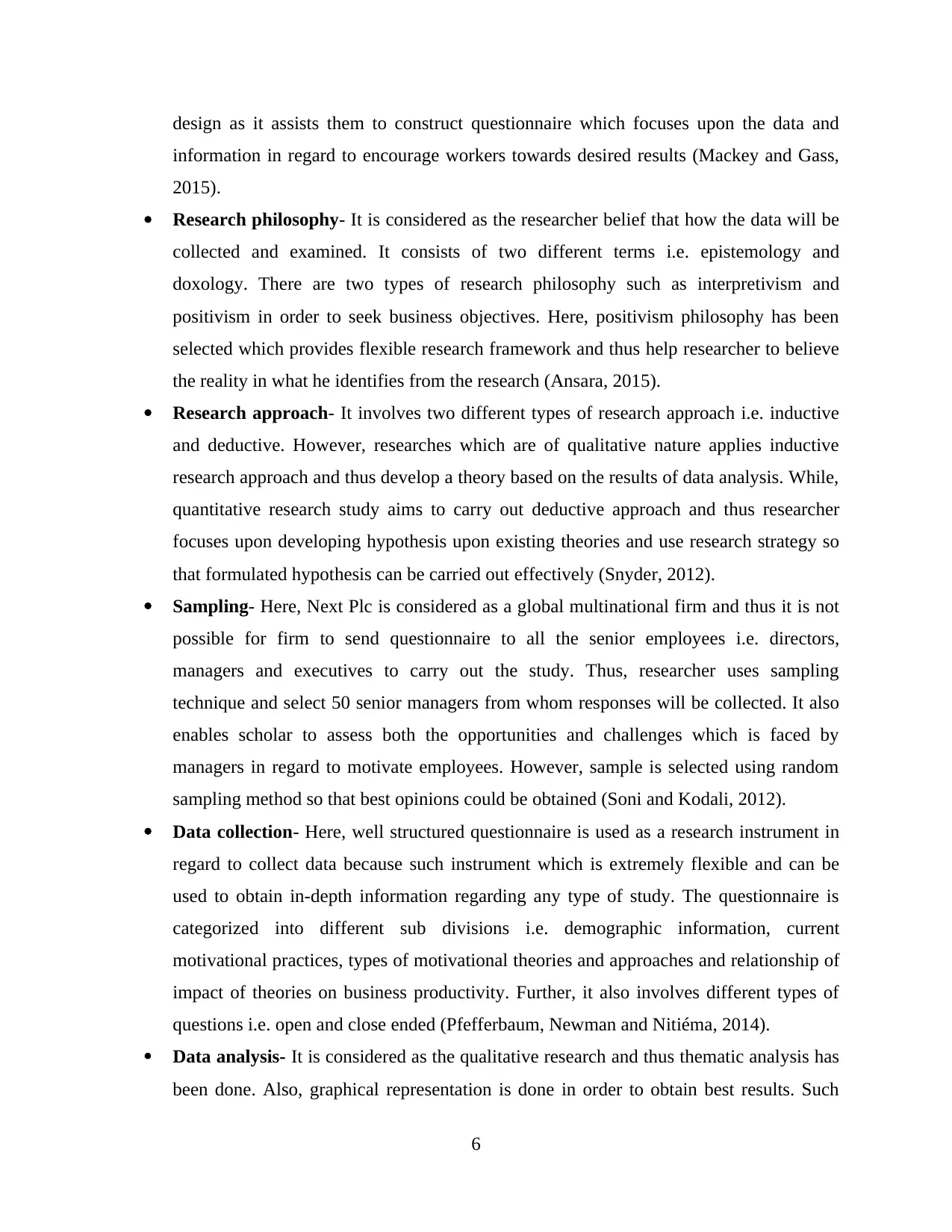
design as it assists them to construct questionnaire which focuses upon the data and
information in regard to encourage workers towards desired results (Mackey and Gass,
2015).
Research philosophy- It is considered as the researcher belief that how the data will be
collected and examined. It consists of two different terms i.e. epistemology and
doxology. There are two types of research philosophy such as interpretivism and
positivism in order to seek business objectives. Here, positivism philosophy has been
selected which provides flexible research framework and thus help researcher to believe
the reality in what he identifies from the research (Ansara, 2015).
Research approach- It involves two different types of research approach i.e. inductive
and deductive. However, researches which are of qualitative nature applies inductive
research approach and thus develop a theory based on the results of data analysis. While,
quantitative research study aims to carry out deductive approach and thus researcher
focuses upon developing hypothesis upon existing theories and use research strategy so
that formulated hypothesis can be carried out effectively (Snyder, 2012).
Sampling- Here, Next Plc is considered as a global multinational firm and thus it is not
possible for firm to send questionnaire to all the senior employees i.e. directors,
managers and executives to carry out the study. Thus, researcher uses sampling
technique and select 50 senior managers from whom responses will be collected. It also
enables scholar to assess both the opportunities and challenges which is faced by
managers in regard to motivate employees. However, sample is selected using random
sampling method so that best opinions could be obtained (Soni and Kodali, 2012).
Data collection- Here, well structured questionnaire is used as a research instrument in
regard to collect data because such instrument which is extremely flexible and can be
used to obtain in-depth information regarding any type of study. The questionnaire is
categorized into different sub divisions i.e. demographic information, current
motivational practices, types of motivational theories and approaches and relationship of
impact of theories on business productivity. Further, it also involves different types of
questions i.e. open and close ended (Pfefferbaum, Newman and Nitiéma, 2014).
Data analysis- It is considered as the qualitative research and thus thematic analysis has
been done. Also, graphical representation is done in order to obtain best results. Such
6
information in regard to encourage workers towards desired results (Mackey and Gass,
2015).
Research philosophy- It is considered as the researcher belief that how the data will be
collected and examined. It consists of two different terms i.e. epistemology and
doxology. There are two types of research philosophy such as interpretivism and
positivism in order to seek business objectives. Here, positivism philosophy has been
selected which provides flexible research framework and thus help researcher to believe
the reality in what he identifies from the research (Ansara, 2015).
Research approach- It involves two different types of research approach i.e. inductive
and deductive. However, researches which are of qualitative nature applies inductive
research approach and thus develop a theory based on the results of data analysis. While,
quantitative research study aims to carry out deductive approach and thus researcher
focuses upon developing hypothesis upon existing theories and use research strategy so
that formulated hypothesis can be carried out effectively (Snyder, 2012).
Sampling- Here, Next Plc is considered as a global multinational firm and thus it is not
possible for firm to send questionnaire to all the senior employees i.e. directors,
managers and executives to carry out the study. Thus, researcher uses sampling
technique and select 50 senior managers from whom responses will be collected. It also
enables scholar to assess both the opportunities and challenges which is faced by
managers in regard to motivate employees. However, sample is selected using random
sampling method so that best opinions could be obtained (Soni and Kodali, 2012).
Data collection- Here, well structured questionnaire is used as a research instrument in
regard to collect data because such instrument which is extremely flexible and can be
used to obtain in-depth information regarding any type of study. The questionnaire is
categorized into different sub divisions i.e. demographic information, current
motivational practices, types of motivational theories and approaches and relationship of
impact of theories on business productivity. Further, it also involves different types of
questions i.e. open and close ended (Pfefferbaum, Newman and Nitiéma, 2014).
Data analysis- It is considered as the qualitative research and thus thematic analysis has
been done. Also, graphical representation is done in order to obtain best results. Such
6
Paraphrase This Document
Need a fresh take? Get an instant paraphrase of this document with our AI Paraphraser
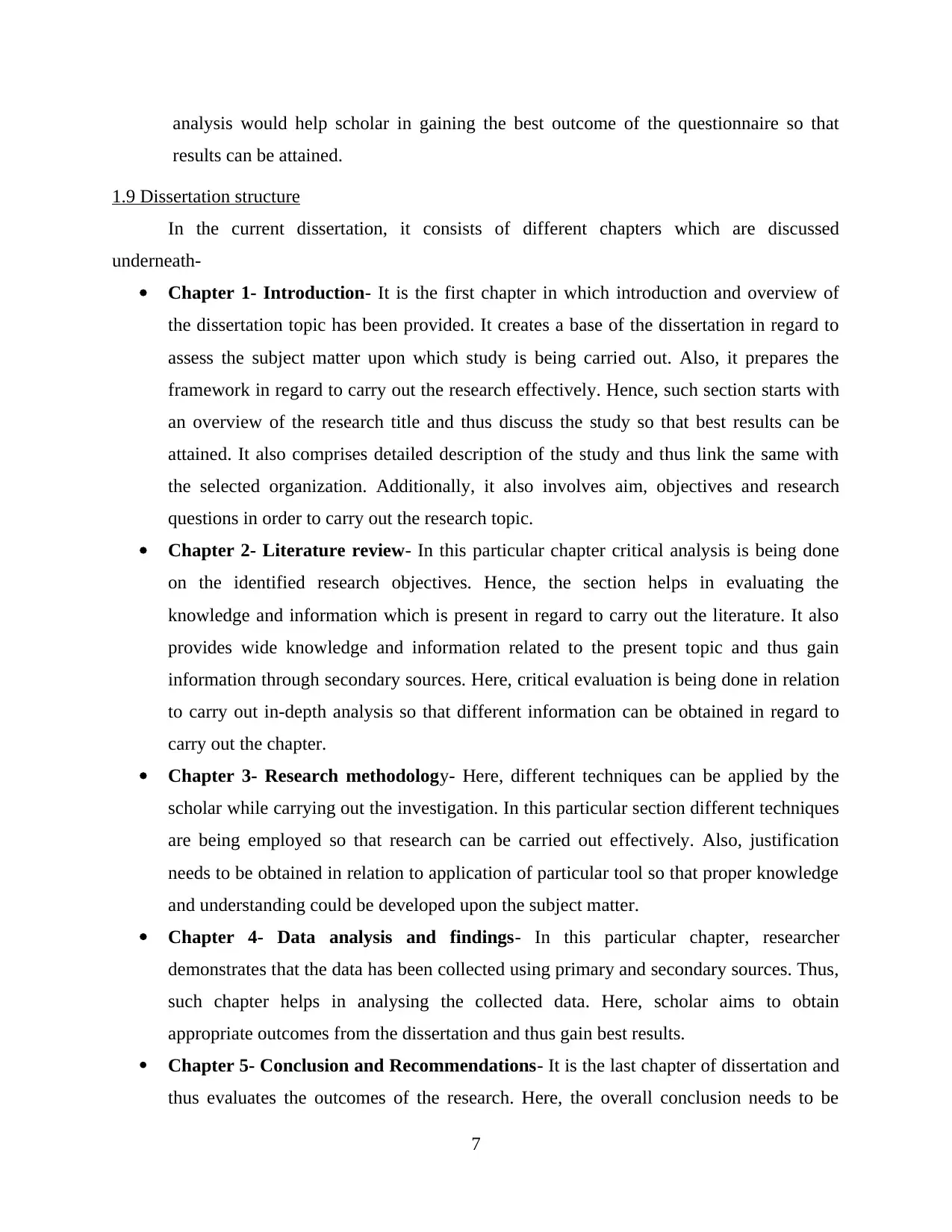
analysis would help scholar in gaining the best outcome of the questionnaire so that
results can be attained.
1.9 Dissertation structure
In the current dissertation, it consists of different chapters which are discussed
underneath-
Chapter 1- Introduction- It is the first chapter in which introduction and overview of
the dissertation topic has been provided. It creates a base of the dissertation in regard to
assess the subject matter upon which study is being carried out. Also, it prepares the
framework in regard to carry out the research effectively. Hence, such section starts with
an overview of the research title and thus discuss the study so that best results can be
attained. It also comprises detailed description of the study and thus link the same with
the selected organization. Additionally, it also involves aim, objectives and research
questions in order to carry out the research topic.
Chapter 2- Literature review- In this particular chapter critical analysis is being done
on the identified research objectives. Hence, the section helps in evaluating the
knowledge and information which is present in regard to carry out the literature. It also
provides wide knowledge and information related to the present topic and thus gain
information through secondary sources. Here, critical evaluation is being done in relation
to carry out in-depth analysis so that different information can be obtained in regard to
carry out the chapter.
Chapter 3- Research methodology- Here, different techniques can be applied by the
scholar while carrying out the investigation. In this particular section different techniques
are being employed so that research can be carried out effectively. Also, justification
needs to be obtained in relation to application of particular tool so that proper knowledge
and understanding could be developed upon the subject matter.
Chapter 4- Data analysis and findings- In this particular chapter, researcher
demonstrates that the data has been collected using primary and secondary sources. Thus,
such chapter helps in analysing the collected data. Here, scholar aims to obtain
appropriate outcomes from the dissertation and thus gain best results.
Chapter 5- Conclusion and Recommendations- It is the last chapter of dissertation and
thus evaluates the outcomes of the research. Here, the overall conclusion needs to be
7
results can be attained.
1.9 Dissertation structure
In the current dissertation, it consists of different chapters which are discussed
underneath-
Chapter 1- Introduction- It is the first chapter in which introduction and overview of
the dissertation topic has been provided. It creates a base of the dissertation in regard to
assess the subject matter upon which study is being carried out. Also, it prepares the
framework in regard to carry out the research effectively. Hence, such section starts with
an overview of the research title and thus discuss the study so that best results can be
attained. It also comprises detailed description of the study and thus link the same with
the selected organization. Additionally, it also involves aim, objectives and research
questions in order to carry out the research topic.
Chapter 2- Literature review- In this particular chapter critical analysis is being done
on the identified research objectives. Hence, the section helps in evaluating the
knowledge and information which is present in regard to carry out the literature. It also
provides wide knowledge and information related to the present topic and thus gain
information through secondary sources. Here, critical evaluation is being done in relation
to carry out in-depth analysis so that different information can be obtained in regard to
carry out the chapter.
Chapter 3- Research methodology- Here, different techniques can be applied by the
scholar while carrying out the investigation. In this particular section different techniques
are being employed so that research can be carried out effectively. Also, justification
needs to be obtained in relation to application of particular tool so that proper knowledge
and understanding could be developed upon the subject matter.
Chapter 4- Data analysis and findings- In this particular chapter, researcher
demonstrates that the data has been collected using primary and secondary sources. Thus,
such chapter helps in analysing the collected data. Here, scholar aims to obtain
appropriate outcomes from the dissertation and thus gain best results.
Chapter 5- Conclusion and Recommendations- It is the last chapter of dissertation and
thus evaluates the outcomes of the research. Here, the overall conclusion needs to be
7

gained after analysing t he data collected. In this section, it provides recommendations as
well on the particular topic so that issues can be overcome.
8
well on the particular topic so that issues can be overcome.
8
⊘ This is a preview!⊘
Do you want full access?
Subscribe today to unlock all pages.

Trusted by 1+ million students worldwide
1 out of 83
Related Documents
Your All-in-One AI-Powered Toolkit for Academic Success.
+13062052269
info@desklib.com
Available 24*7 on WhatsApp / Email
![[object Object]](/_next/static/media/star-bottom.7253800d.svg)
Unlock your academic potential
Copyright © 2020–2025 A2Z Services. All Rights Reserved. Developed and managed by ZUCOL.





